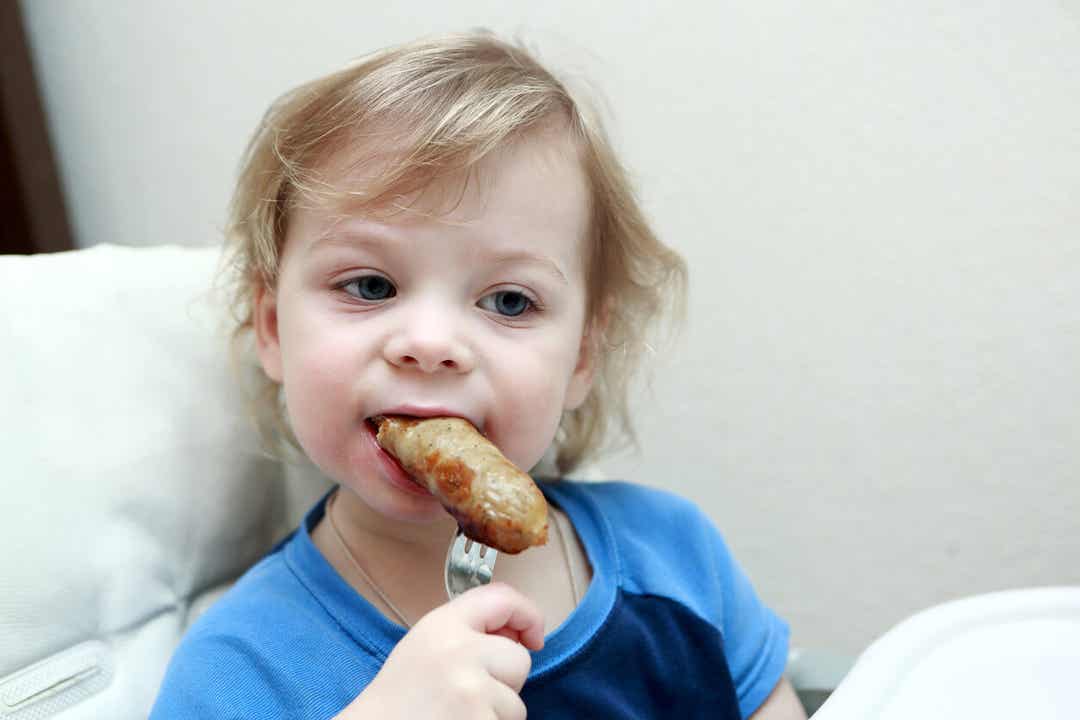Why are Hot Dogs and Sausages Dangerous for Children?

Hotdogs and sausages are foods that are often part of a child’s diet. However, experts advise against their consumption. They’re made from very low-quality ingredients that could affect the health of children in the medium term. In fact, we could go so far as to say that hot dogs and sausages are dangerous for children.
It’s important to note that one of the priorities in terms of public health is the reduction of the presence of ultra-processed products in the diet. Hot dogs and sausages fall into this group. Instead, it’s preferable to include fresh foods such as meats, fish, eggs, and vegetables.
What do sausages contain?
In general, sausages consist of low-quality meat scraps, potato starch, and additives, including preservatives. Many of them, such as nitrates, contribute to an increased risk of developing some types of cancer. A study in Medical Science Monitor demonstrates just that.

It’s important to note that science hasn’t been able to prove that the consumption of red meat is harmful to the body. However, its processing and the use of chemical substances may have to do with a higher incidence of certain complex illnesses. For this reason, experts recommend reducing its presence in the diet.
Sausages are dangerous for children
As a study published in the International Journal of Cancer states, regular consumption of processed red meat leads to an increased risk of cancer, especially colon and breast cancer. This is also due to the use of very low-quality scraps of the animal, usually waste.
However, the use of spices manages to improve the taste of sausages in their final form, which makes them more appetizing to children. This is dangerous because they can become accustomed to eating them and demand them frequently, despite them not being quality products.
It’s essential to carry out nutritional education during the first stages of life, as the habits acquired here will be maintained later on. In this sense, it’s good to emphasize the intake of fresh meats under less aggressive cooking methods, such as grilling or baking.
Are hot dogs and sausages dangerous? Other healthier fast foods
Although sausages aren’t a good option for the diet (not even for children), there are other meat-based preparations that can be healthier. For example, homemade hamburgers are safe. It’s important to ask the butcher to chop a good quality lean piece. Once at home, you can prepare the hamburgers yourself with spices and without chemicals.
This way, you control the process of elaboration of the meat from beginning to end, thus ensuring its healthiness. What’s more, your children will want to eat it, and you’ll be eliminating the risk that’s present in hot dogs and sausages.
You should keep in mind that opting for the fast track in the kitchen doesn’t usually produce good results. It’s better to spend a little more time on the elaborations and to obtain final food of good quality, without additives that can be dangerous for health.

Are hot dogs and sausages dangerous? Prevent children from consuming sausages
The presence of hot dogs and sausages in the diet of children isn’t at all beneficial. These are very low-quality foods that contain leftovers and waste. They don’t have a high nutritional density and contain substances that could be harmful to health in the medium term. In short, hot dogs and sausages are dangerous for children.
It’s important to get children used to eating fresh quality food. The fewer sausages and processed meat derivatives are we include in their diets, the better. In the case of making any similar preparation, such as hamburgers, it’s best for the whole process to be homemade so that you can control the ingredients that go in.
Keep in mind that the habits that you implement during the first stages of life will condition your child’s health in the future. It’s key to pay attention to them.
Hotdogs and sausages are foods that are often part of a child’s diet. However, experts advise against their consumption. They’re made from very low-quality ingredients that could affect the health of children in the medium term. In fact, we could go so far as to say that hot dogs and sausages are dangerous for children.
It’s important to note that one of the priorities in terms of public health is the reduction of the presence of ultra-processed products in the diet. Hot dogs and sausages fall into this group. Instead, it’s preferable to include fresh foods such as meats, fish, eggs, and vegetables.
What do sausages contain?
In general, sausages consist of low-quality meat scraps, potato starch, and additives, including preservatives. Many of them, such as nitrates, contribute to an increased risk of developing some types of cancer. A study in Medical Science Monitor demonstrates just that.

It’s important to note that science hasn’t been able to prove that the consumption of red meat is harmful to the body. However, its processing and the use of chemical substances may have to do with a higher incidence of certain complex illnesses. For this reason, experts recommend reducing its presence in the diet.
Sausages are dangerous for children
As a study published in the International Journal of Cancer states, regular consumption of processed red meat leads to an increased risk of cancer, especially colon and breast cancer. This is also due to the use of very low-quality scraps of the animal, usually waste.
However, the use of spices manages to improve the taste of sausages in their final form, which makes them more appetizing to children. This is dangerous because they can become accustomed to eating them and demand them frequently, despite them not being quality products.
It’s essential to carry out nutritional education during the first stages of life, as the habits acquired here will be maintained later on. In this sense, it’s good to emphasize the intake of fresh meats under less aggressive cooking methods, such as grilling or baking.
Are hot dogs and sausages dangerous? Other healthier fast foods
Although sausages aren’t a good option for the diet (not even for children), there are other meat-based preparations that can be healthier. For example, homemade hamburgers are safe. It’s important to ask the butcher to chop a good quality lean piece. Once at home, you can prepare the hamburgers yourself with spices and without chemicals.
This way, you control the process of elaboration of the meat from beginning to end, thus ensuring its healthiness. What’s more, your children will want to eat it, and you’ll be eliminating the risk that’s present in hot dogs and sausages.
You should keep in mind that opting for the fast track in the kitchen doesn’t usually produce good results. It’s better to spend a little more time on the elaborations and to obtain final food of good quality, without additives that can be dangerous for health.

Are hot dogs and sausages dangerous? Prevent children from consuming sausages
The presence of hot dogs and sausages in the diet of children isn’t at all beneficial. These are very low-quality foods that contain leftovers and waste. They don’t have a high nutritional density and contain substances that could be harmful to health in the medium term. In short, hot dogs and sausages are dangerous for children.
It’s important to get children used to eating fresh quality food. The fewer sausages and processed meat derivatives are we include in their diets, the better. In the case of making any similar preparation, such as hamburgers, it’s best for the whole process to be homemade so that you can control the ingredients that go in.
Keep in mind that the habits that you implement during the first stages of life will condition your child’s health in the future. It’s key to pay attention to them.
All cited sources were thoroughly reviewed by our team to ensure their quality, reliability, currency, and validity. The bibliography of this article was considered reliable and of academic or scientific accuracy.
- Zhang FX, Miao Y, Ruan JG, Meng SP, Dong JD, Yin H, Huang Y, Chen FR, Wang ZC, Lai YF. Association Between Nitrite and Nitrate Intake and Risk of Gastric Cancer: A Systematic Review and Meta-Analysis. Med Sci Monit. 2019 Mar 9;25:1788-1799. doi: 10.12659/MSM.914621. PMID: 30850575; PMCID: PMC6420797.
- Diallo A, Deschasaux M, Latino-Martel P, Hercberg S, Galan P, Fassier P, Allès B, Guéraud F, Pierre FH, Touvier M. Red and processed meat intake and cancer risk: Results from the prospective NutriNet-Santé cohort study. Int J Cancer. 2018 Jan 15;142(2):230-237. doi: 10.1002/ijc.31046. Epub 2017 Oct 16. PMID: 28913916.
This text is provided for informational purposes only and does not replace consultation with a professional. If in doubt, consult your specialist.








